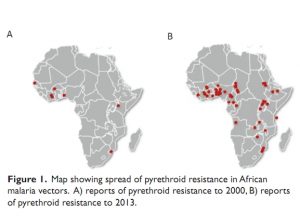Facing the resistance crisis in Malaria Control by developing and evaluating “Resistance-Breaking” products
Prevention of malaria is best achieved by controlling the mosquito vector which, today in Africa relies almost entirely on the use of residual insecticides inside the home. Wide scale implementation of tools such as indoor residual spraying (IRS) and long lasting insecticide impregnated bednets (LLINs) have led to impressive decreases in malaria transmission in some regions and these interventions are the cornerstone of malaria control programmes in most African countries.
 These two interventions are largely reliant on a single class of insecticides, the pyrethroids. Only pyrethroids can be used to treat bednets and, although four insecticide classes are approved by the World Health Organisation for use in IRS, the vast majority of programmes spray with pyrethroids. An inevitable consequence of the scale up of malaria control has been the emergence of insecticide resistance in the Anopheles vectors. Pyrethroid resistance was first detected in Anopheles gambiae in West Africa in 1993 and remained relatively rare until the end of the twentieth century. But in the past 10 years reports of pyrethroid resistance in the major African malaria vectors have escalated (Figure 1) (Ranson et al, 2011).
These two interventions are largely reliant on a single class of insecticides, the pyrethroids. Only pyrethroids can be used to treat bednets and, although four insecticide classes are approved by the World Health Organisation for use in IRS, the vast majority of programmes spray with pyrethroids. An inevitable consequence of the scale up of malaria control has been the emergence of insecticide resistance in the Anopheles vectors. Pyrethroid resistance was first detected in Anopheles gambiae in West Africa in 1993 and remained relatively rare until the end of the twentieth century. But in the past 10 years reports of pyrethroid resistance in the major African malaria vectors have escalated (Figure 1) (Ranson et al, 2011).
Action must be taken to ensure that this resistance does not compromise malaria control. The AvecNet project (www.avecnet.eu) was established in 2011, with funding from the European Union Framework 7 programme, with the goal of developing new or improved mosquito control tools to complement existing interventions and control insecticide resistant populations. Some of the key activities and outputs from this project are described.
This is an preview of a full article published in Outlooks on Pest Management – February 2014 issue.
The full text of this article is available to subscribers of Outlooks on Pest Management.
Non-subcribers may buy & download fulltext article.
Author: Hilary Ranson, Head of Department of Vector Biology, Liverpool School of Tropical Medicine, Pembroke Place, Liverpool, L3 5QA, UK
Category: Public health










